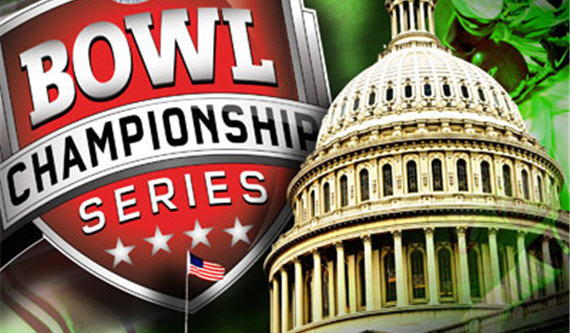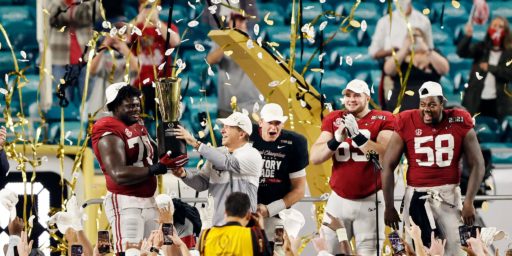College Football Coaches Salaries Soar As College Budgets Fall
College football coaching salaries jumped 35 percent last year and 55 percent in the last six.
The Nation‘s Dave Zirin is outraged by seemingly conflicting trend lines in university spending: money for academics is tight but money for football coaches is at an all-time high.
Given the grey, budgetary realities that surround a typical state university, these numbers will boggle the mind. According to USA Today, salaries of new head football coaches at the 120 bowl-eligible schools increased by 35 percent in 2011. The average pay has now ballooned to $1.5 million annually. That’s an increase from $1.1 million. Over the last six seasons, football coach salaries have risen by an astonishing 55 percent. Think about that. In an era of stagnating and falling wages nationally, compensation for coaching a college football team traces a trend line that rises like a booster’s adrenaline during bowl season. It doesn’t matter how bad the tuition hikes, the furloughs or the layoffs might be: the dynamic of paying football coaches more continues unabated.
Presumably, the answer is that college football coaches and college professors are paid from different pots of money and operate in completely separate markets. Whereas professors and administrators at state schools are paid out of tax coffers and whatever money the university can generate from endowments, capital campaigns, and all the rest football coaches are paid out of athletic budgets raised by boosters and corporate sponsors. Whereas we PhDs are a dime a dozen, there are a relative handful of proven winners at head coach.
A little over five years ago, I explained Why Nick Saban Makes More Than Your Kid’s Teacher. Two national championships later, I rest my case. But Zirin notes something I’ve noted many times in this space, too: Alabama is not representative of college football programs, even many of the major ones.
An NCAA report showed that just fourteen of the 120 Football Bowl Subdivision schools made money from campus athletics in the 2009 fiscal year, down from just twenty-five the year before. Public universities, particularly in an era of austerity, preach, with a catch in their throat, that the revenue just isn’t there.
Then again, college football tends to make money at the elite level. But, along with men’s basketball, it’s asked to pay for all the rest of the university’s sports programs, almost all of which are revenue drains. A handful of schools make money from women’s basketball and sports which have a huge tradition on that particular campus. Most, though, have a fan base comparable to a pee wee football league but with much higher overhead.
College presidents still treat football like a prize pig to be protected at all costs despite the fact that more than three-fourths of them don’t “believe that big-time intercollegiate athletics are sustainable in their current form.”
The proof, however, is in their actions. Ohio State University, one of the schools so touched by scandal, landed the biggest free-agent fish, hiring former Florida head coach Urban Meyer for $24 million over six years. At Penn State, after the hiring of New England Patriots assistant Bill O’Brien to replace Joe Paterno, O’Brien fired more than a half-dozen assistants and now the public state college will be paying $4.4 million in severance. This number doesn’t include what will be paid to Paterno or to quarterbacks coach Mike McQueary, who is currently on “administrative leave” as a prosecutorial witness against former assistant/accused child predator Jerry Sandusky. But Ohio State and Penn State, for all the slathered scandal across their campuses, have football programs that propel athletic departments toward positive total revenue. For most schools, this isn’t close to the case. Instead, you get the University of Maryland paying former Coach Ralph Friedgen $2 million to go home and not coach, while cutting numerous teams from the athletic department. But whether a school is generating revenue or taking an awful bath, the coaching arms race continues. Penn State emeritus professor John Nichols, chair of the Coalition on Intercollegiate Athletics, a faculty group advocating for athletics reform, said of the head coaching wage hikes, “This just shows…the difficulty of bringing (football) into the right proportion, the right balance with the academic mission.”
I was on the faculty at Troy (then Troy State) when it was contemplating and ultimately making the move from highly competitive I-AA (now FCS) program to I-A (now FBS) patsy. Most of us objected but our chancellor, Jack Hawkins, argued, correctly it turns out, that anything between Division III and Division I-A was a no man’s land. That is, once you start offering scholarships and traveling a long way to play games, college sports is simply a money drain unless you’re at the big time level and benefiting from network television deals and all the rest.
The obvious retort is that most schools should either cancel competitive athletics altogether, or relegate themselves to intramurals or very low level regional sports to keep costs down. Essentially, the high school model. And, indeed, many schools do just that.
Many elite universities–the Ivies, NYU, and the University of Chicago, perhaps most notably–have managed to have national and international reputations without big time sports. Then again, those schools had the advantage of being among the first universities in the country. For that matter, they all had big time sports programs in the early days of college athletics before eventually deciding the arms race wasn’t worth it. Even so, most of the great academic schools in the country–Stanford, Berkeley, UCLA, Michigan, Duke, North Carolina, etc.–coexist with big time sports.
The problem is that most college presidents want to maintain or increase the profiles of their schools. That’s what drove Hawkins to move Troy to the big leagues: a hope that it would put his school on the map. In Troy’s case, it likely worked: the school has a much higher national profile–which is to say, people outside Alabama are now aware that it exists–than it did as a I-AA football power. Similarly, who had heard of Boise State before its recent run of football success? Or Texas Christian?
Probably a better example is the NCAA men’s basketball tournament, which grabs the nation’s attention for two weeks every year. How many schools that nobody ever heard of suddenly gain national recognition each year by winning a game or two during March Madness? Even established schools with strong academic programs report huge boosts in applications after a successful tourney run.
The bottom line is that college presidents see sports, and football in particular, as the easiest way to market their schools. Asking why they’re spending more to lure successful coaches while they’re cutting core programs is like asking why corporations are spending more on advertising while they’re laying off workers.
Hat tip: Margaret Soltan







It’s a matter of priorities and marketing. Education should be prioritized, but marketing demands that you have football. Alumni will show up and donate when football is involved. It is much harder to get anyone to donate for a new English department. I dont really blame the universities, they are just reflecting the values of their consumers.
However, I think it is more problematic at the high school level. The wife had Fox on this morning. They were moaning about government spending cuts in Texas. It was just awful that spending was going to be cut. The spending in question? High school football.
Steve
The way to really decide big time college sports are the schools that have hangers-on (Wal-Mart Alumni) versus the schools that don’t.
The Ohio States, Michigans, Penn State, Alabama, or Oklahoma is that they have a large number of fans that did not attend the university. Patsy’s in Div I (old term) will never have hangers-on and thus should drop sports. Even schools with good academics and successful sports programs do not have hangers-on such as Stanford or Vanderbilt. Out of the private schools, only Duke’s mens basketball, has hangers-on and that is only due to being the only winning program that has a majority of white players.
College sports should move to a model of about 50 schools that have hangers-on and everyone else should either drop sports or move to Div III.
Your headline has “… as College Budgets Fall”. I am very curious, can you please provide the name of a major university that is ACTUALLY spending less this year than say two years ago?
I am not talking about a proposed budget increase of, let’s say 6% that was reduced to an increase of 2.5%. That is NOT a cut in actual spending. The one I look at UNC Chapel Hill for example, despite the talk of “budget cuts”, when you look at their published financial statements, the actual spending is still going up.
Also what needs to be mentioned about any conversation on college spending is the growth in folks working on the non-academic side. I have seen studies that this is where the majority (not all of course) of increased spending has gone during the last 20 years.
@superdestroyer:
Jesus Christ, is there any issue that doesn’t come down to minorities you?
Part of the issue is that school shouldn’t have to be in the same division for every sport. If there’s a sport that makes money, go Division 1 in it. If I can’t, go Division III.
The elephant in the room then is Title IX. On one hand recognizing that providing athletic oppurtunities to women is an important goal, on the other hand there’s the simple reality that people simply don’t turn out for women’s sports the way they do for men’s sports.
I’m not sure what the proper balance is, but I don’t think the current situation is the right one.
@Stormy Dragon: Birds gonna fly, fish gonna swim and race-baiters gonna race-bait.
Pretty difficult to rally around a physics class (except at maybe MIT). Seems like simple supply and demand. Great coaches typically make great fundraisers. Look at Mack Brown.
What I’d like to see is a study of whether the gains from cheating (winning leads to more donations, exposure, etc.) outweigh the costs of punishment (bowl bans, loss of scholarships, etc.).
I wouldn’t be at all surprised if an enterprising AD commissioned his Moneyball stat-guys to look into the matter,
The main problem is that it is a rat race. The University of Northern Colorado wants to be Colorado State. Colorado State wants to be Colorado. Colorado wants to be Texas. If Florida Atlantic wants to differentiate itself from North Florida, and be more like the University of South Florida, the best way to do so is to try field a team that UNF doesn’t. Until UNF does, then you try to get a better coach and a better team so that you can be in a better conference. Which takes money.
The athletics budget accounts for less than 5% of my alma mater’s total budget. It’s outrageous to some because that’s millions and millions of dollars. It also attracts a lot of attention because it’s the front porch of the school. But, because it’s the front porch of the school, it makes my school more well-known than schools that are academically superior.
How many people have heard of Georgia State University? It’s a good school… but a lot more people have heard of Troy. Boise State is the third best university out of three comprehensive universities in Idaho, but who has heard of Idaho State University (#2)?
All of which is to say that I agree with Joyner. And to say that I simply don’t see a way out of this unless the NCAA starts telling schools that they cannot move up the latter.
@Stormy Dragon:
The support of white fans throughout the U.S. for the Duke University basketball team is one of the recurring topics is the sports media. If you ever look around during college basketball season and see which university t-shirts people are wearing. I doubt that you will ever find a black kid wearing a Duke University t-shirt but you will find whites from LA to Seattle to Maine wearing Duke basketball T-shirts.
However, if you go to Alabama or Louisiana or Georgia you will find black and white people wearing t-shirts for Alabama, Auburn, LSU, or Georgia. That is the difference in hangers-on.
Since it has been many years since I have lived in Texas, I would love to know if there are black kids in Houston or Dallas walking around with UT Longhorn T-shirts.
Also, the NCAA requires Div-I football schools to have a minimum of eight sports. That is why schools like Oklahoma State have women’s soccer and Equestrian. The NCAA will not let the football schools to opt out of having other sports.
@superdestroyer: “Whitey-ditey-hitey-white. Black-black-blackity-black.”
You’d save a lot of time if you just cut and paste the above in your future comments.
@Ben Wolf:
It is amazing that even though progressives claim that they are fact-based and rational, they still refuse to face anything that does not reinforce their view of the world.
Even something as leftist as thehuffingpost has written about how race affects the way fans view Duke Basketball. http://www.huffingtonpost.com/rob-kirkpatrick/the-racial-biases-of-duke-hating_b_839560.html
You will never find a black kid wearing a Duke University T-shirt. You should ask yourself why. Of course, these are the same kids who think that Georgetown University is heavily black because the basketball team is all black.
@Trumwill:
But how many of those school in Colorado have any fans other that people associated with the university. I never felt that even CU has that many hangers-on. That is why those schools are lose money on their athletic programs.
@superdestroyer:
Go back to your Klan meeting. You’re the only one interested in what color college jocks are.
@bandit: While superdestroyer’s tendency to see race in everything gets on my nerves sometimes, I’ve not attempted to shut him down–as I have a few others with that tendency–because his arguments are generally cogent. While I think he overstates the degree to which race is an issue in sports fandom above, for example, he’s almost certainly right that it’s a significant factor. And, indeed, the Duke basketball example is probably a good one.
When I moved to the DC exurbs some years back, I was shocked to the degree that Dallas Cowboys paraphernalia was displayed in the hometown of their most heated rival. Partly, that’s a fact that a huge number of people in the area, like myself, grew up liking the Cowboys elsewhere and kept rooting for our team even after moving here. And, of course, the Cowboys, Steelers, and Packers have huge fan bases everywhere.
But there’s another reason. Back in the days when the Cowboys were coming into the league–despite the efforts of the then-Redskins owner to keep them out, fearing that they would cut into what was then (1960) a Redskins monopoly on the South. That same owner was also an inveterate racist who resisted integrating the team long after black superstars were dominating the NFL. Consequently, a considerable number of black football fans in DC and its environs came to root for the Cowboys. While that particular motivation is presumably all but gone, a large number of black fans who grew up in this area nonetheless root for the Cowboys to this day.
@James Joyner:
If you think that thinking about race is sports is long gone, you should read Jason Whitlock’s column from two days ago http://msn.foxsports.com/nfl/story/baltimore-ravens-new-england-patriots-tom-brady-ray-lewis-ultimate-culture-clash-011912
Sports is the U.S. has always had a racial component and always will. From Jack Johnson to the Duke Lacrosse scandal, race has always been involved in sports.
@superdestroyer: Oh, I fully agree that race is a significant component in sports, and society as a whole. I just see it as a 15 percent issue whereas you apparently see it as a 98 percent issue.
Duke’s Charles Clotfelter writes very well on this subject, as his 2011 book “Big-Time Sports in American Universities” deftly demonstrates.
@Erica L. Canti:
Thanks for citing Charles Clotfelter. I found his article on diversity in extra-curricular activites interesing. If confirms what anyone who attended a diverse high school already knew. http://www.nber.org/papers/w7999.pdf